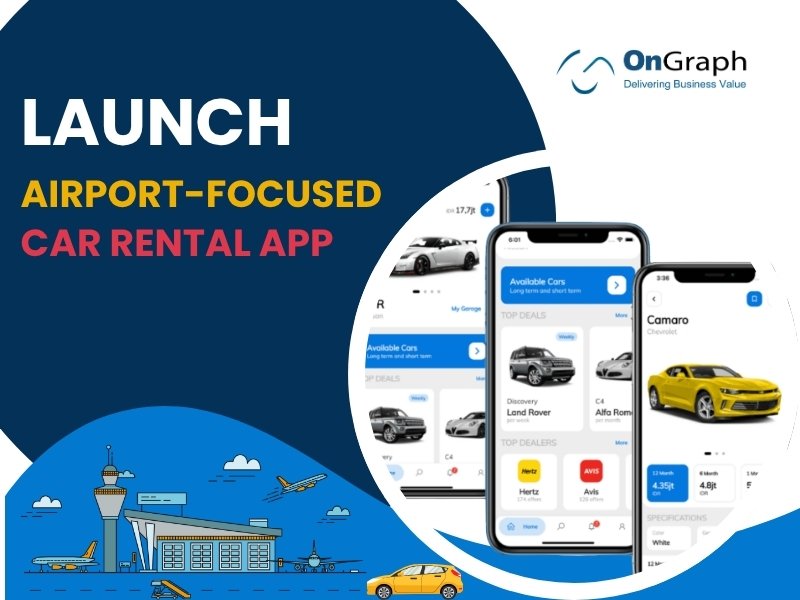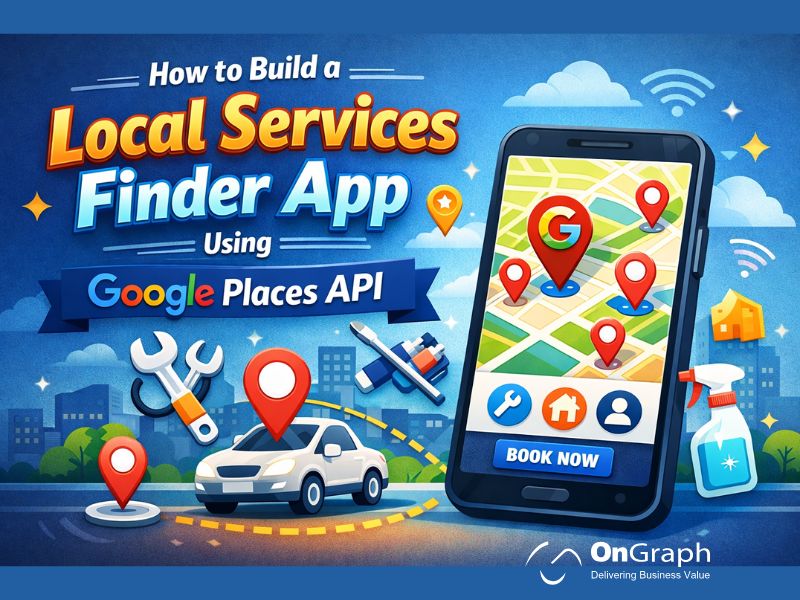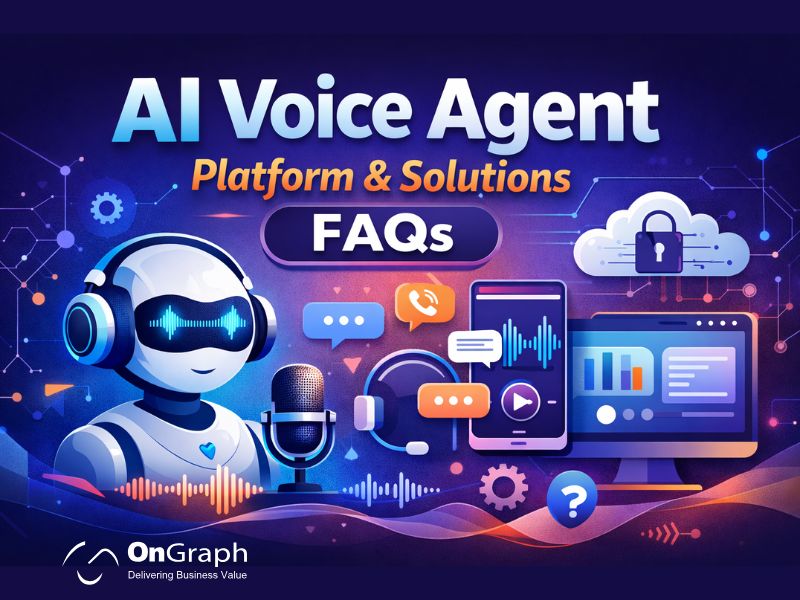In this article
- The Market Opportunity for Airport Car Rental App Development
- Defining the Product: What Makes an Airport-Focused Car Rental App?
- Key Features for Your Airport-Focused Car Rental App
- Technology Architecture & Infrastructure Strategies
- Fleet Hub Strategy & 5-Minute Pickup Promise
- Pricing Strategy & Membership Model
- User Experience & Booking Flow
- Compliance, Fleet Maintenance & Safety
- Marketing & Growth Strategy
- Launch Checklist for Airport-Focused Car Rental App Development
- Conclusion
If you are planning to launch an airport-focused car rental app, this in-depth guide gives you the full roadmap—from market insights and fleet hub strategy to tech architecture, user experience, payments and launch checklist.
With airport mobility evolving rapidly, a well-designed airport-focused car rental app can become a competitive business if built and executed smartly.
The Market Opportunity for Airport Car Rental App Development
Airport car rental is a major segment of the broader rental market. The global market for airport car rental services was valued at USD 33.18 billion in 2024, and is projected to reach USD 45.05 billion by 2032, at a CAGR of ~4.4%.
Within the car rental industry overall, the global market is projected to grow from around USD 153 billion in 2025 to USD 253 billion by 2030.
For airport-focused use cases, convenience, travel volume and accessibility drive demand. One study shows that the “airport transport” application segment accounted for over 38 % of car rental revenue share in 2024.
Key drivers for an airport-focused car rental app development strategy include:
- High-value travellers needing rapid pickup and reliable fleet access
- Opportunity for premium car categories and business rental segments
- Digital booking adoption: one article states ~80 % of car rentals are booked via apps/websites.
- Fleet utilisation around airport hubs ois ften higher, because of high turnover and captive audience
Thus, investing in an airport-focused car rental app and corresponding fleet hub ecosystem makes strong business sense.
Defining the Product: What Makes an Airport-Focused Car Rental App?
When you define your airport-focused car rental app development roadmap, these capabilities become essential:
Rapid pickup & hub-based logistic model
Your app should allow a user arriving at an airport to book and target a 5-minute pickup (or as near as feasible). The supply of vehicles must be staged in mini-hubs or lots near terminals rather than distant depot locations. This is critical to the “airport-first” promise.
Fleet hub design & staging
Create multiple fleet hubs: one near airport terminal, another at nearby lot/parking, and optional local pickup locations. Vehicles should cycle quickly through bookings, drop-offs and next-bookings to maintain high utilisation.
Booking-flow and real-time tracking
User opens app, selects “airport pickup”, enters flight number (optional), chooses vehicle category, pays/reserves, receives live ETA of vehicle at terminal. This aligns with modern consumer expectations and emphasises “airport car rental app development”.
Fleet categories & pricing tiers
Offer economy, premium, luxury categories. Tiered membership levels (e.g., “Elite”, “Standard”) also help. The user should see clear pricing and availability at the airport hub instantly.
Fleet management and utilisation dashboards
Admin/ops team needs real-time dashboard: vehicle status (available, in transit, cleaning, maintenance), driver assignment, hub occupancy, inventory turnover. High data transparency is crucial for success.
Mobile payments & digital contracts
Self-serve payment and contract completion via mobile: card, mobile wallet, digital signature, insurance add-ons. This reduces friction at arrival.
Multi-service readiness
Although starting with car rentals, the platform should allow future expansion to ride-hailing, chauffeur service, and corporate contracts — this is consistent with the broader trend for “fleet and mobility platforms”.
By focusing your product definition around these pillars you align your execution to the airport-focused car rental app development market and expectations.
Key Features for Your Airport-Focused Car Rental App
Here is a list of must-have features for your platform:
- Instant airport pickup booking workflow
- Flight number integration & arrival monitoring (optional)
- Live driver/vehicle tracking map at airport hub
- Vehicle availability and category browsing right after flight arrival
- Hub location selection with vehicle staging times
- Pricing transparency with tiered membership & dynamic fares
- Mobile contract signing, insurance add-ons, and payment wallet
- Driver onboarding, vehicle assignment workflow
- Fleet status dashboard (admin panel) for hubs, vehicles, drivers, utilisation
- Maintenance & cleaning scheduling for rapid turnaround
- Analytics and reporting: bookings, idle time, utilisation per hub, revenue per vehicle
- Support for future expansion to chauffeur, ride-hailing or corporate bookings
These features help your airport-focused car rental app development strategy stand out, deliver superior user experience, and provide operational control.
Technology Architecture & Infrastructure Strategies
Choosing the right tech architecture underpins your ability to deliver scale, reliability and cost efficiency.
Cloud-first and scalable backend
A microservices architecture on e.g. AWS (or alternative cloud) supports modular scaling of booking engine, inventory service, payments, analytics. This helps when you scale beyond one airport hub.
Serverless components
Where possible, use serverless functions (AWS Lambda or equivalent) for non-persistent tasks (pricing engine, notification triggers, booking event processing). This reduces idle cost and supports dynamism.
Real-time data and tracking
Use WebSocket or push notifications for live tracking, vehicle arrival updates, driver status. GPS tracking should be integrated with mobile app and fleet dashboard.
Payment gateway & wallet
Integrate with payment provider, maintain user and driver wallets, enable instant payouts (or scheduled). Include fraud detection, KYC for drivers.
Vehicle & hub status engine
Backend services maintain pool of vehicles per hub, their status (available/in transit/cleaning/maintenance), driver schedule, assignment logic.
Analytics & reporting layer
Leverage data warehouse and BI dashboards for fleet utilisation, idle time, revenue per vehicle, membership usage, dynamic pricing performance.
Mobile apps (iOS + Android) & driver app
User app: booking, payment, tracking, support.
Driver/hub app: job assignment, arrival notifications, vehicle status, hub check-in/out.
Admin web portal: fleet/hub management, reporting, finances.
By deploying a robust technical infrastructure your airport-focused car rental app development will be both future-proof and scalable.
Fleet Hub Strategy & 5-Minute Pickup Promise
One of the key differentiators for an airport-focused car rental app is the “5-minute pickup” promise. Here’s how to operationalise that:
Hub-based staging
Locate hub(s) within 2-3 minutes of airport terminals or in dedicated parking lot near processing gate. Vehicles remain ready, cleaned, insured, staffed and on-call.
Pre-booking enablement
Allow users to pre-book before arrival (via flight number). Seat vehicle slot in hub. On arrival user sees live ETA and driver assignment.
Dynamic vehicle allocation
Use demand forecasting (based on flight schedules, arrival times, days of week) to stage more vehicles when arrivals are concentrated. Use analytics to manage peak times.
Rapid turnaround & cleaning
Vehicles leave hub, drop passenger, return within short time, cleaned, refuelled, ready for next job. This high turnover improves fleet utilisation and supports the 5-minute pickup promise.
Driver shift planning
Hub operations must plan driver availability to match arrivals schedule. Idle drivers next to hub reduce waiting time and maximise customer satisfaction.
Monitoring & SLA
Track key metric: time from arrival check-in → vehicle pickup. Use dashboards to identify bottlenecks and continuously optimise.
This operational model supports your aim of delivering a superior user experience, and aligns with your airport-focused car rental app development positioning.
Pricing Strategy & Membership Model
Setting the right pricing and membership structure will drive profitability and customer loyalty.
Dynamic pricing
Analyze competitor rates (airport rental agencies, local platforms), arrival volumes, vehicle availability and repositioning cost. Implement fare surges for peak arrival windows. One pricing study shows rental prices from airports are often significantly higher than downtown alternatives.
Tiered memberships
Offer membership levels (e.g., Standard, Elite) with benefits like guaranteed vehicle within 5 minutes, free upgrades, reduced cancellation fees, fixed pricing windows. Memberships encourage repeat usage and predictable revenue.
Utilisation and idle cost control
Monitor vehicle downtime and idle costs per hub. Higher utilisation means lower per-trip cost. Use data from your analytics layer to optimise fleet size and hub density.
Upsell & cross-sell
Offer vehicle category upgrades, chauffeur service, airport lounge check-in, add-ons like GPS, child seat. This increases average order value.
Transparent pricing in app
Ensure the user sees full price, breakdown of cost, waiting charges, cleaning fee, mileage limits. Clarity improves trust and reduces complaints.
By combining dynamic pricing with membership benefits and clear value proposition, your airport-focused car rental app development project can generate healthy margins and scale effectively.
User Experience & Booking Flow
A seamless booking and user experience is core to the success of your airport-focused car rental app.
Pre-arrival booking interface
- User opens the app, selects “Airport Pickup”.
- Enters flight number or arrival time.
- Selects vehicle category.
- Confirms pickup hub/lot location and sees “5-minute” badge (or realistic number).
- Pays and receives confirmation.
Arrival & vehicle tracking
- App sends ETA updates and live map tracking of vehicle.
- Push notification when vehicle arrives.
- Digital contract and insurance confirmation inside app.
Hub check-in
- Driver meets at arrival lot or designated hub zone.
- Quick identity verification, driver logs in, vehicle ready.
Trip in progress & drop-off
- User drives and on drop-off, app triggers invoice, payment is captured from wallet/card.
- User and driver rate each other, allowing feedback loop.
Post-trip analytics for the user
- Dashboard shows membership benefits, earned points, offers for next booking.
By focusing on speed, clarity, live tracking and branded hub experience, the user experience of your airport-focused car rental app will stand out.
Compliance, Fleet Maintenance & Safety
Running an airport-based rental service requires strong operations around maintenance, safety and regulatory compliance.
Driver and vehicle verification
- Drivers: licence, background check, airport security clearance (if required).
- Vehicles: registration, insurance, maintenance schedule, hub inspection post-each drop-off.
Hub safety protocols
- Vehicles cleaned and inspected before next job.
- Real-time telematics monitor vehicle health (fuel, mileage, engine diagnostics).
- Dashcams or driver logging help ensure safety and liability coverage.
Data protection and payment compliance
- Handle user payment data securely, comply with regional and industry regulations (PCI-DSS if applicable).
- Maintain audit trail for payments, membership subscriptions, cancellations.
Airport zone regulations
- Airport pickup/drop-off often requires permits, parking space allocations, signage, airport fees.
- Work with airport authority to secure hub location and agree on SLA metrics.
Insurance and incident response
- Define insurance coverage for vehicle loss/damage, user injury, third-party liability.
- Incident reporting protocol built into driver/hub app, with admin oversight.
Ensuring high standards of compliance, fleet maintenance and safety builds trust with users and airports — key to your airport-focused car rental app development success.
Marketing & Growth Strategy
Getting initial traction and scaling your airport-focused car rental app requires clear marketing and growth playbook.
Airport partnerships and branding
- Partner with airlines, travel agents, hotel concierges, airport lounges to promote your service.
- Branding at terminal (kiosks, signage, pickup zones) reinforces premium experience.
Digital acquisition
- SEO & SEM targeting “airport car rental app”, “airport pickup car rental”, “5 minute rental pickup”.
- App store optimisation: include “Airport-focused car rental app” key phrase in description.
- Social media campaigns emphasising 5-minute promise, hub convenience, membership perks.
Referral & loyalty programmes
- Member invites friend → both get ride credit or upgrade.
- Frequent users get free upgrades, VIP access to hub, reduced fees.
Corporate & B2B deals
- Offer contracts to businesses for airport transport of staff/executives.
- Provide analytics dashboard for corporate clients (fleet usage, cost per trip, reporting).
Expand to adjacent services
- Once core airport rental app is running, add airport chauffeur service, ride to city, parcel delivery for arriving travellers. This transition supports long-term growth for such platforms.
By executing a focused growth plan with both consumer and B2B segments, your airport-focused car rental app development will reach scale faster.
Launch Checklist for Airport-Focused Car Rental App Development
Here is a practical checklist to guide your launch:
- Market research: airport arrival volumes, competitor pricing, hub locations
- Fleet hub site selection: near terminal, parking, clearance with airport authority
- Vehicle acquisition & staging: categories, cleaning, maintenance logistics
- App development: user app, driver app, admin dashboards
- Booking and pickup workflow built with app, GPS tracking & notifications
- Payment gateway, wallet, contract signing module
- Membership programme and pricing model defined
- Analytics and dashboard set up: utilisation, idle time, revenue per vehicle
- Driver onboarding & vehicle inspection process
- Safety, compliance, and insurance systems in place
- Marketing launch plan: airport partnerships, digital marketing, referral
- Pilot launch at one hub → measure KPIs (pickup time, bookings/day, idle rate)
- Full rollout across hubs with scale plan
By following this checklist you create a structured path for your airport-focused car rental app development.
Conclusion
An airport-focused car rental app development initiative offers immense market potential and strong differentiation if executed with the right strategy.
Partnering with an experienced Taxi App Development Company can help you design and deploy a solution that ensures rapid airport pickups, hub-based vehicle staging, seamless booking and payment, and scalable fleet operations.
By combining expert technical architecture with data-driven fleet management, your platform can deliver a smooth travel experience for airport users.
With strategic planning around fleet hubs, pricing, user experience, and marketing, you can position your service as the go-to mobility platform for arriving travellers.
Ready to Launch Your Own Car Rental App? Let’s Build It Smarter & Faster!
FAQs
Building such an app depends on scope and scale. Costs include: mobile apps (iOS + Android), driver app, admin panel, backend services, real-time tracking, payment integration, membership module, fleet hub logistics. For an MVP using a white-label base you might start from tens of thousands USD. A full custom system with fleet hub logistics, telematics integration and airport partnerships could cost significantly more. Additional costs include vehicles, hub leasing, cleaning/maintenance staff, airport fees, marketing and operations. You should budget for pilot operations and turnaround time plus a buffer for local regulations and scaling.
Key features include: rapid airport pickup flow, vehicle availability at hub, live tracking of vehicle arrival, real-time notifications, tiered membership, mobile payment and wallet support, fleet hub dashboard, vehicle status/maintenance tracking, driver app with assignments, analytics reporting. Without these features your value proposition (five-minute pickup at airport) will not differentiate. Effective fleet hub logistics and operations support are as important as the mobile app itself.
To deliver the 5-minute pickup promise you must stage vehicles very near the terminal in attached or dedicated lots. Use arrival data (flight tracking) when possible, anticipate block of arrivals, have drivers on standby at hub, use app notifications to driver and user. Deploy geofences and priority zones for airport hub vehicles. Monitor and optimise key metrics: arrival to pickup, vehicle idle time, driver shift scheduling. Continuous data feedback loops will refine the process.
A good hub model includes one or more lots very near airport terminal (such as off-airport but within 2-3 minutes), vehicles cleaned and ready for next job, drivers pre-logged into driver app, real-time vehicle staging system. Consider dedicated parking spaces at arrival zone, clear signage. Hub must support turnaround: vehicle cleaning, refuelling, maintenance, and next booking cycle. Logistics such as staff, spare vehicles, support vehicles must also be factored in.
Pricing should be transparent and reflect premium airport pickup service. Consider base fare + time/distance + pickup zone premium. Dynamic pricing for peak arrivals. Membership tiers (Standard, Elite) can offer benefits (guaranteed vehicle, free upgrade, shorter wait time). You may also bundle benefits like free waiting for first 10 minutes, free cancellation window. Membership helps drive repeat usage and predictable revenue. Also monitor competitor airport rental pricing to stay competitive.
A cloud-first architecture is highly recommended. Use microservices for booking, inventory, payment, analytics. Leveraging serverless (e.g., AWS Lambda) for event-driven tasks reduces cost and supports scale. Real-time tracking requires WebSocket or push service, GPS integration. Mobile apps should be native or cross-platform depending on budget. Back-end must support hub vehicle status updates, driver app interactions, push notifications. Analytics layer must collect data for utilisation, idle time, bookings per vehicle. Choosing a scalable, modular tech stack ensures your airport-focused car rental app development is resilient and future-ready.
Key challenges: securing airport hub location and permits, staging vehicles near terminal, aligning driver availability with arrival times, dealing with vehicle idle time/turnaround logistics, managing maintenance and cleaning, building user trust in new brand, differentiating from conventional airport rental desks, regulatory compliance and insurance burden. Mitigation: start with a pilot hub in one airport, partner with airport authority early, plan driver shifts and hub staffing around arrival data, build operations for quick turnover, integrate telematics for vehicle status, emphasise premium user experience, use digital payment to streamline process, gather user feedback and iterate fast.
About the Author
Let’s Create Something Great Together!
Latest Blog
















